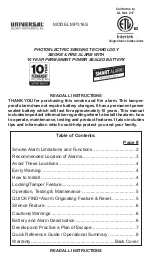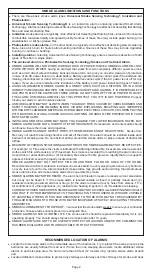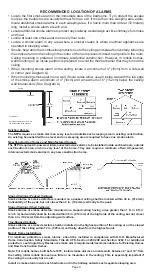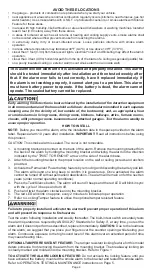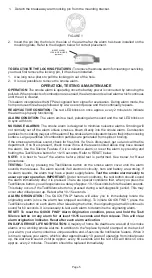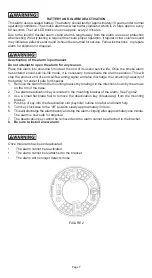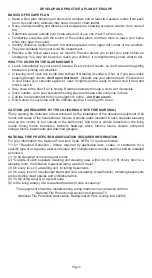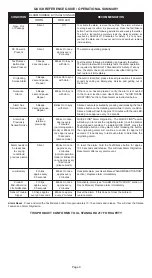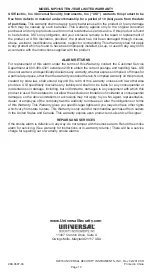
Page 4
Early warning fire detection is best achieved by the installation of fire detection equipment
in all rooms and areas of the household as follows: A smoke alarm installed in each separate
sleeping area (in the vicinity of, but outside of, the bedrooms); and, as appropriate, heat
or smoke alarms in living rooms, dining rooms, kitchens, hallways, attics, furnace rooms,
closets, utility storage rooms, basements and attached garages. Test the alarms weekly to
assure proper operation.
HOW TO INSTALL
NOTE:
Before you mount the alarm, write the installation date in the space provided on the alarm
label. Replace alarm 10 years after installation.
IMPORTANT:
Read all instructions before using
this product.
CAUTION: This smoke alarm is sealed. The cover is not removable.
1. A mounting bracket is provided on the back of the alarm. Remove the mounting bracket from
the back of the alarm by holding the mounting bracket and twisting the alarm in the direction
indicated by the “TWIST TO REMOVE” arrow on the side of the alarm base.
2. Attach the mounting bracket in the proper location on the wall or ceiling (screws and anchors
provided.
3. Activate the Permanent Power battery feature by removing and discarding the battery pull tab.
The alarm will sound one long beep to confirm it is powered up. Once activated, the alarm
cannot be turned off without permanent deactivation. The alarm will remain on for the next ten
years (under normal operating conditions).
4. Press the Test/Silence button. The alarm will sound 3 beeps and the red LED will blink in sync
with the cycle of 3 beeps and turn off.
5. Push and twist the alarm clockwise onto the mounting bracket.
6. The red LED will blink on approx. every 2 minutes to indicate proper operation.
7. Refer to Locking/Tamper feature to utilize the optional tamper resistant feature.
This alarm will not work until it is activated and properly installed. This alarm
should be tested immediately after installation and then tested weekly after
that. If the alarm ever fails to test correctly, have it replaced immediately. If
the alarm is not working properly, it cannot alert you to a problem. This alarm
must have battery power to operate. If the battery is dead, the alarm cannot
operate. The sealed battery cannot be replaced.
Failure to properly install and activate this alarm will prevent proper operation of this alarm
and will prevent its response to fire hazards.
Test the alarm following installation and weekly thereafter. The built-in test switch accurately tests
the alarm operation as required by ANSI/UL217 Standards for Safety. If, at any time, you test the
alarm and it does not perform as described, replace it immediately.
CAUTION:
Due to the loudness
of the alarm, we suggest that you place your fingers over the sounder opening while testing your
alarm. Continuous exposure to the high sound level of this alarm over an extended period of time
may cause hearing loss.
OPTIONAL TAMPER RESISTANT FEATURE:
The tamper resistant locking feature for this model
deters someone from removing the alarm from the mounting bracket. The breakaway locking pin
is clearly marked and molded into the mounting bracket. Refer to Figure 1.
TO ACTIVATE THE ALARM LOCKING FEATURE:
Do not activate the locking feature until you
have activated the battery, mounted the smoke alarm to the bracket and tested the smoke alarm.
Refer to OPERATION, TESTING & MAINTENANCE instructions on Page 5.
AVOID THESE LOCATIONS
• the garage – products of combustion are produced when you start your vehicle.
• near appliances or areas where normal combustion regularly occurs (kitchens, near furnaces, gas hot
water heaters). Use smoke alarms with U.S.S.T. or photoelectric sensors, or smoke alarms with Silence
Feature for these areas.
• in areas with high humidity, like bathrooms or areas near dishwashers or washing machines. Install at
least 3 feet (0.9 meters) away from these areas.
• in areas of turbulent air such as air returns or heating and cooling supply vents, smoke alarms shall
not be located where airflow prevents smoke from reaching the alarms.
• in extremely dusty, dirty or insect-infested areas. Loose particles interfere with smoke alarm
operation.
• in areas where temperature may fall below 40
0
F (4.4
0
C) or rise above 100
0
F (37.8
0
C).
• closer than 1 foot (0.3m) from fluorescent lights, electrical "noise" and flickering may affect the alarm's
operation.
• closer than 3 feet (0.9m) horizontal path from the tip of the blade of a ceiling suspended (paddle) fan.
• on a poorly insulated ceiling or exterior wall (mount smoke alarm on an inside wall).

